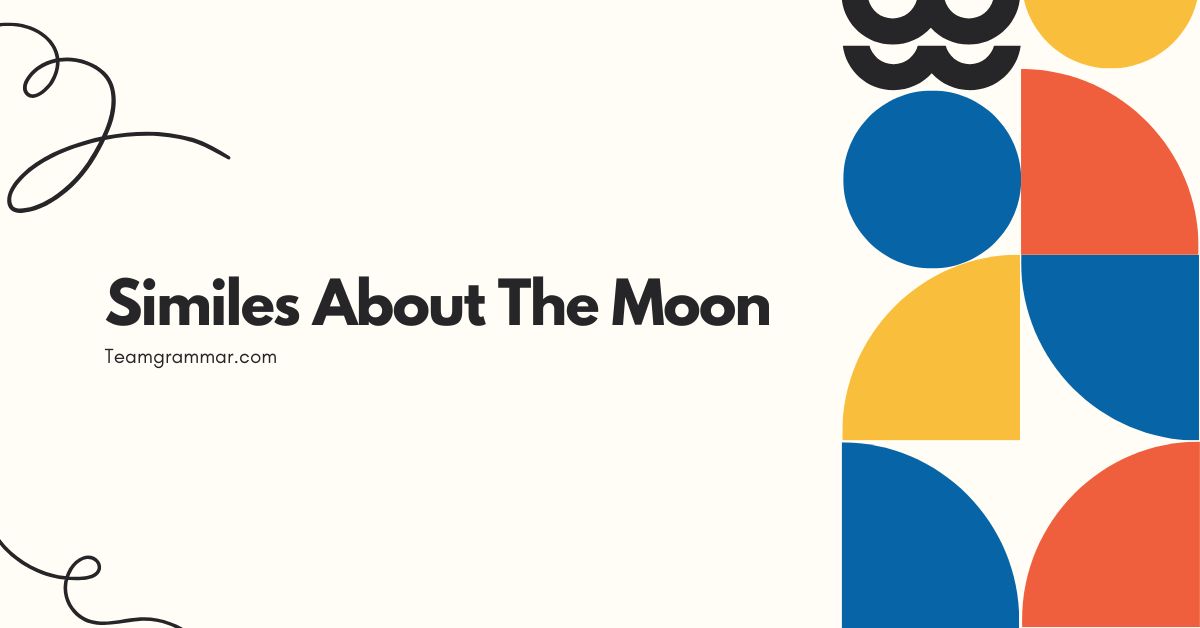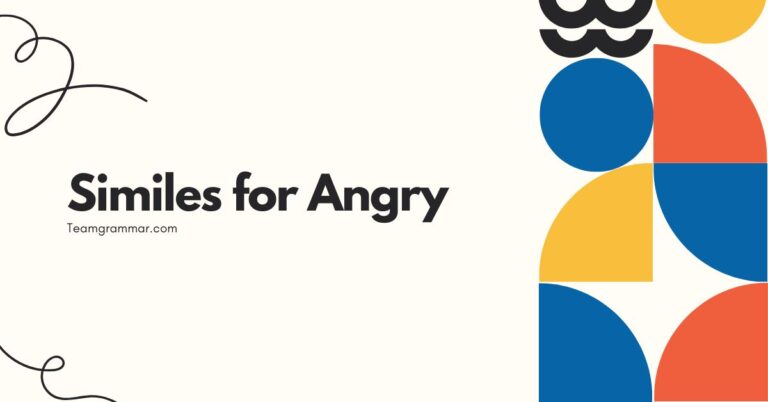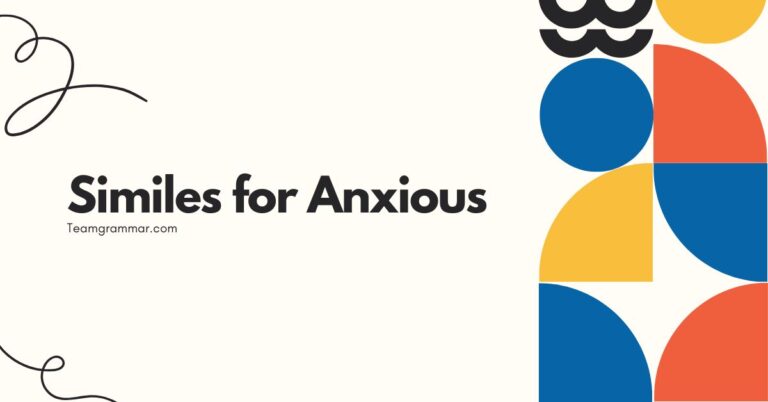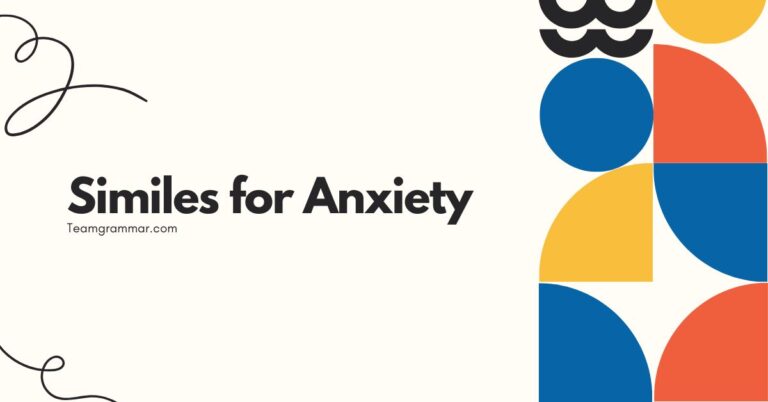43 Similes About The Moon: A Comprehensive Grammar Guide
Understanding similes is crucial for enhancing descriptive writing and appreciating figurative language. Similes, a cornerstone of English grammar and literary expression, allow us to draw comparisons between different things, making our language more vivid and engaging.
This article focuses specifically on similes related to the moon, exploring their structure, usage, and impact. Whether you’re a student learning the basics or a writer looking to refine your skills, this guide will provide you with the knowledge and tools to effectively use similes in your writing and speech.
Table of Contents
- Introduction
- Definition of a Simile
- Structural Breakdown of Similes
- Types of Similes
- Examples of Moon Similes
- Usage Rules for Similes
- Common Mistakes with Similes
- Practice Exercises
- Advanced Topics: Extending Simile Usage
- Frequently Asked Questions
- Conclusion
Definition of a Simile
A simile is a figure of speech that directly compares two different things using the words “like” or “as.” The primary function of a simile is to enhance description and make writing more engaging by creating a vivid image in the reader’s mind. Similes help to explain something unfamiliar by relating it to something familiar.
This makes complex ideas easier to understand and adds depth to our communication.
Classification of Similes
Similes belong to the broader category of figurative language, which includes metaphors, personification, and hyperbole. Unlike a metaphor, which states that one thing *is* another, a simile only suggests a resemblance.
This distinction is crucial because it maintains a level of separation between the two compared items. Similes are a fundamental tool in both creative writing and everyday conversation.
Function of Similes
The main function of a simile is to create a stronger, more descriptive image in the reader’s or listener’s mind. By drawing a comparison, similes can highlight specific qualities or characteristics of the subject being described.
This makes the writing more vivid and memorable. Similes can also be used to simplify complex ideas or emotions by relating them to something more easily understood.
They are a powerful tool for enhancing communication and creative expression.
Contexts for Using Similes
Similes are widely used in various contexts, from literature and poetry to everyday conversation and advertising. In literature, they add depth and imagery to the narrative.
In poetry, they enhance the emotional impact of the verse. In everyday conversation, they help us to express ourselves more clearly and creatively.
In advertising, they are used to make products more appealing by associating them with desirable qualities. The versatility of similes makes them a valuable tool in any form of communication.
Structural Breakdown of Similes
The basic structure of a simile involves three key components: the subject, the comparison word (“like” or “as”), and the object of comparison. Understanding this structure is essential for creating effective and meaningful similes.
The Subject
The subject is the thing being described or compared. It is the focal point of the simile.
For example, in the simile “The moon was like a ghostly galleon,” the subject is “the moon.” The subject is what the writer or speaker wants to describe in more detail.
The Comparison Word
The comparison word is either “like” or “as.” These words are crucial because they indicate that a comparison is being made, rather than a direct statement of equivalence. The choice between “like” and “as” is often a matter of stylistic preference, although “as” is sometimes used in more formal contexts.
The Object of Comparison
The object of comparison is the thing to which the subject is being compared. It should share some quality or characteristic with the subject, allowing for a meaningful comparison.
In the example “The moon was like a ghostly galleon,” the object of comparison is “a ghostly galleon.” The object of comparison helps to illuminate a particular aspect of the subject.
Types of Similes
Similes can be categorized based on their function and the type of comparison they make. Understanding these categories can help you to use similes more effectively in your writing.
Descriptive Similes
Descriptive similes are used to provide a more vivid description of the subject. They often focus on physical characteristics or sensory details.
For example, “The moon was as bright as a spotlight” is a descriptive simile that emphasizes the moon’s brightness.
Explanatory Similes
Explanatory similes are used to clarify or explain something by comparing it to something more familiar. They help the reader to understand the subject better.
For example, “Understanding astrophysics is like trying to catch smoke with your bare hands” is an explanatory simile that conveys the difficulty of understanding astrophysics.
Emotional Similes
Emotional similes are used to convey emotions or feelings by comparing them to something that evokes a similar emotional response. They add depth and emotional resonance to the writing.
For example, “Feeling lost is like being a lone astronaut drifting away from the moon” is an emotional simile that conveys the feeling of isolation and disorientation.
Examples of Moon Similes
Here are several examples of similes that use the moon as either the subject or the object of comparison. Each example is categorized to illustrate the different ways similes can be used.
Descriptive Similes about the Moon
These similes focus on describing the moon’s appearance, brightness, or other physical characteristics. They aim to create a vivid image of the moon in the reader’s mind.
The table below provides 30 examples.
| Simile | Explanation |
|---|---|
| The moon was like a silver coin in the sky. | Emphasizes the moon’s round shape and silvery color. |
| The moon was as bright as a spotlight. | Highlights the moon’s intense brightness. |
| The moon was like a ghostly galleon sailing through the clouds. | Creates a mysterious and ethereal image. |
| The moon was as pale as a ghost. | Emphasizes the moon’s pale and spectral appearance. |
| The moon was like a pearl in the velvet sky. | Highlights the moon’s beauty and preciousness. |
| The moon was as round as a dinner plate. | Focuses on the moon’s circular shape. |
| The moon was like a beacon in the darkness. | Emphasizes the moon’s role as a guiding light. |
| The moon was as cold as ice. | Highlights the moon’s perceived coldness. |
| The moon was like a silent watcher in the night. | Creates a sense of mystery and observation. |
| The moon was as white as snow. | Emphasizes the moon’s pure white color. |
| The moon was like a celestial lantern. | Highlights the moon’s illuminating quality. |
| The moon was as large as a beach ball. | Exaggerates the moon’s apparent size. |
| The moon was like a diamond in the dark. | Emphasizes the moon’s brilliance and beauty. |
| The moon was as soft as a whisper. | Highlights the moon’s gentle and subtle presence. |
| The moon was like a clock in the night sky. | Suggests the moon’s predictable and cyclical nature. |
| The moon was as still as a statue. | Emphasizes the moon’s unchanging presence. |
| The moon was like a watchful eye. | Creates a sense of being observed. |
| The moon was as lonely as a single star. | Highlights the moon’s isolation. |
| The moon was like a forgotten dream. | Suggests the moon’s distant and ethereal nature. |
| The moon was as fragile as glass. | Emphasizes the moon’s delicate appearance. |
| The moon was like a painted mask. | Highlights the moon’s unchanging facade. |
| The moon was as distant as a memory. | Emphasizes the moon’s remoteness. |
| The moon was like a silver tear. | Creates a sense of sadness and beauty. |
| The moon was as mysterious as the ocean’s depths. | Highlights the moon’s enigmatic nature. |
| The moon was like a hole in the fabric of night. | Suggests the moon’s unique presence in the darkness. |
| The moon was as quiet as a sleeping child. | Emphasizes the moon’s peacefulness. |
| The moon was like a silent song. | Highlights the moon’s subtle beauty. |
| The moon was as constant as the tides. | Emphasizes the moon’s reliable presence. |
| The moon was like a mirror reflecting the sun’s light. | Highlights the moon’s reflective nature. |
| The moon was as timeless as the stars. | Emphasizes the moon’s enduring presence. |
Similes Comparing Things to the Moon
These similes use the moon as the object of comparison to describe other things. They often focus on qualities like brightness, roundness, or calmness.
The table below provides 30 examples.
| Simile | Explanation |
|---|---|
| Her face was like the moon, round and full of light. | Emphasizes the person’s round face and radiant complexion. |
| His smile was as bright as the moon. | Highlights the person’s radiant and joyful smile. |
| The lake was like a mirror, reflecting the moon’s glow. | Emphasizes the lake’s reflective surface and the moon’s influence. |
| Her eyes were as calm as the moonlit sea. | Highlights the person’s peaceful and serene eyes. |
| The snow-covered field was like a canvas painted by the moon. | Emphasizes the moon’s role in illuminating the landscape. |
| His voice was like the moon, soft and soothing. | Highlights the person’s gentle and calming voice. |
| The city at night was as enchanting as the moon. | Emphasizes the city’s magical and captivating atmosphere. |
| Her hair was like moonbeams, shimmering in the dark. | Highlights the person’s lustrous and radiant hair. |
| The silence was as profound as the dark side of the moon. | Emphasizes the deep and mysterious silence. |
| His wisdom was like the phases of the moon, ever-changing and insightful. | Highlights the person’s evolving and profound wisdom. |
| The pearl was as lustrous as the moon. | Emphasizes the pearl’s radiant and captivating shine. |
| Her skin was like moonlight, pale and ethereal. | Highlights the person’s fair and otherworldly complexion. |
| The night was as still as the face of the moon. | Emphasizes the night’s peaceful and tranquil atmosphere. |
| His heart was as cold as the dark side of the moon. | Highlights the person’s emotional detachment and coldness. |
| The fog was like the moon’s shadow, obscuring everything in its path. | Emphasizes the fog’s ability to conceal and obscure. |
| Her tears were as luminous as moon drops. | Highlights the person’s radiant and striking tears. |
| The music was like the moon, haunting and beautiful. | Emphasizes the music’s ethereal and captivating qualities. |
| His touch was as gentle as moonlight. | Highlights the person’s soft and delicate touch. |
| The dream was as elusive as capturing the moon in a jar. | Emphasizes the dream’s intangible and unattainable nature. |
| Her laughter was like moon chimes, delicate and enchanting. | Highlights the person’s light and captivating laughter. |
| The memory was as faded as an old moon print. | Emphasizes the memory’s diminished and distant nature. |
| His gaze was like the moon’s pull, irresistible and strong. | Highlights the person’s compelling and influential gaze. |
| The path was as winding as the moon’s orbit. | Emphasizes the path’s circuitous and intricate nature. |
| Her secret was as hidden as the far side of the moon. | Highlights the secret’s concealed and mysterious nature. |
| The feeling was as fleeting as moon shadows. | Emphasizes the feeling’s transient and ephemeral nature. |
| His promise was as dependable as the moon’s cycle. | Highlights the promise’s reliable and steadfast nature. |
| The night was as serene as a moonlit garden. | Emphasizes the night’s tranquil and peaceful atmosphere. |
| Her spirit was as free as the moon soaring through the sky. | Highlights the person’s unrestrained and liberated spirit. |
| The old house was like a weathered moon, standing against time. | Emphasizes the house’s resilience and enduring presence. |
| His words were as wise as the moon’s ancient silence. | Highlights the depth and insightfulness of his words. |
Similes Using the Moon to Describe Feelings
These similes use the moon to evoke certain feelings or emotional states. They often describe feelings of loneliness, peace, or mystery.
The table below provides 20 examples.
| Simile | Explanation |
|---|---|
| Feeling lost is like being a lone astronaut drifting away from the moon. | Conveys a sense of isolation and disorientation. |
| Her happiness was as full as a harvest moon. | Emphasizes the completeness and abundance of her joy. |
| His sadness was like the dark side of the moon, hidden and profound. | Highlights the depth and secrecy of his sorrow. |
| Their love was as constant as the phases of the moon. | Emphasizes the enduring and cyclical nature of their affection. |
| The anticipation was like waiting for the new moon, full of promise and mystery. | Highlights the excitement and uncertainty of waiting. |
| His anger was as cold as the lunar surface. | Emphasizes the person’s frigid and unforgiving rage. |
| Her fear was like the moon’s shadow, lurking in the dark corners of her mind. | Highlights the person’s hidden and pervasive fear. |
| His hope was as faint as a sliver of the moon. | Emphasizes the fragility and scarcity of his hope. |
| The peace was as deep as the craters on the moon. | Highlights the profound and undisturbed tranquility. |
| Her dreams were like moonbeams, elusive and ethereal. | Emphasizes the intangible and otherworldly nature of her dreams. |
| His regret was as heavy as the moon’s gravity. | Emphasizes the person’s burdening and inescapable regret. |
| Her longing was like reaching for the moon, unattainable and distant. | Highlights the person’s unfulfillable and remote desire. |
| His memory of her was as clear as a moonlit night. | Emphasizes the person’s vivid and memorable recollection. |
| The mystery was as vast as the space between the earth and the moon. | Highlights the immensity and unknowability of the mystery. |
| Her comfort was as gentle as the moon’s soft glow. | Emphasizes the person’s tender and soothing comfort. |
| His courage was as unwavering as the moon’s nightly presence. | Highlights the person’s steadfast and constant bravery. |
| Her curiosity was like exploring the uncharted regions of the moon. | Emphasizes the person’s adventurous and inquisitive nature. |
| His loneliness was as profound as the moon’s solitary journey through space. | Highlights the person’s deep and isolated loneliness. |
| Her joy was like bathing in the light of a full moon. | Emphasizes the person’s radiant and immersive happiness. |
| The disappointment was as stark as seeing the moon eclipsed. | Highlights the person’s sudden and profound disappointment. |
Usage Rules for Similes
Using similes effectively requires adherence to certain rules and guidelines. These rules ensure that the simile is clear, meaningful, and adds value to the writing.
Clarity and Relevance
A good simile should be clear and easy to understand. The comparison should be relevant and make sense to the reader.
Avoid using obscure or overly complex comparisons that could confuse the audience. For example, a clear simile would be “The moon was like a silver coin,” while an unclear simile might be “The moon was like a quantum entanglement.”
Originality and Freshness
While some common similes are effective, strive for originality and freshness in your comparisons. Overused similes can become clichés and lose their impact.
Try to find new and interesting ways to relate things to the moon. For example, instead of saying “The moon was as round as a ball,” try “The moon was like a celestial pearl.”
Contextual Appropriateness
The simile should be appropriate for the context in which it is used. Consider the tone, audience, and purpose of the writing.
A simile that is appropriate for a poem might not be suitable for a scientific report. Ensure that the simile aligns with the overall message and style of the piece.
Avoiding Mixed Metaphors
Be careful to avoid mixed metaphors, which occur when two unrelated comparisons are combined in a way that creates confusion. For example, “The moon was like a silver coin, sailing through the sea of stars” mixes the image of a coin with the image of a ship, creating a disjointed and confusing simile.
Maintain consistency in your comparisons to ensure clarity.
Common Mistakes with Similes
Several common mistakes can undermine the effectiveness of similes. Recognizing and avoiding these errors will help you to use similes more skillfully.
Using Metaphors Instead of Similes
One common mistake is using metaphors instead of similes, or vice versa. Remember that a simile uses “like” or “as” to make a comparison, while a metaphor states that one thing *is* another.
Incorrect: “The moon is a silver coin.” Correct: “The moon is like a silver coin.”
Using Cliches
Overusing clichés can make your writing seem unoriginal and uninspired. Avoid common similes that have lost their impact through overuse.
Incorrect: “The moon was as bright as the sun.” Correct: “The moon was as bright as a spotlight.”
Inconsistent Comparisons
Ensure that the comparison made by the simile is consistent and logical. Avoid comparing things that have little or no connection.
Incorrect: “The moon was like a bicycle.” Correct: “The moon was like a wheel in the sky.”
Overusing Similes
While similes can enhance writing, using too many can make it seem forced and unnatural. Use similes sparingly and only when they add significant value to the description.
Too many similes can clutter the writing and distract the reader.
Practice Exercises
Test your understanding of similes with these practice exercises. For each question, choose the best simile or identify the error in the given simile.
Exercise 1: Identifying Correct Similes
Choose the best simile from the options provided.
| Question | Options | Answer |
|---|---|---|
| Which of the following is the best simile to describe the moon? | a) The moon is a light. b) The moon is like a silver coin. c) The moon is silver. | b) The moon is like a silver coin. |
| Which of the following is the best simile to describe a calm lake at night? | a) The lake is the moon. b) The lake is like a mirror reflecting the moon. c) The lake is a mirror. | b) The lake is like a mirror reflecting the moon. |
| Which of the following is the best simile to describe a person’s smile? | a) His smile is the moon. b) His smile is like the sun. c) His smile is as bright as the moon. | c) His smile is as bright as the moon. |
| Which of the following is the best simile to describe feeling lost? | a) Feeling lost is space. b) Feeling lost is like being an astronaut drifting from the moon. c) Feeling lost is the moon. | b) Feeling lost is like being an astronaut drifting from the moon. |
| Which of the following is the best simile to describe her tears? | a) Her tears are moon drops. b) Her tears are like moon drops. c) Her tears are the moon. | b) Her tears are like moon drops. |
| Which of the following is the best simile to describe his heart? | a) His heart is the moon. b) His heart is like the cold side of the moon. c) His heart is cold. | b) His heart is like the cold side of the moon. |
| Which of the following is the best simile to describe her voice? | a) Her voice is the moon. b) Her voice is soft. c) Her voice is like the moon. | c) Her voice is like the moon. |
| Which of the following is the best simile to describe the night? | a) The night is the face of the moon. b) The night is as still as the face of the moon. c) The night is still. | b) The night is as still as the face of the moon. |
| Which of the following is the best simile to describe the music? | a) The music is the moon. b) The music is haunting. c) The music is like the moon. | c) The music is like the moon. |
| Which of the following is the best simile to describe his gaze? | a) His gaze is the moon. b) His gaze is intense. c) His gaze is like the moon’s pull. | c) His gaze is like the moon’s pull. |
Exercise 2: Correcting Incorrect Similes
Identify and correct the error in each of the following incorrect similes.
| Incorrect Simile | Corrected Simile | Explanation |
|---|---|---|
| The moon is a silver coin. | The moon is like a silver coin. | Changed the metaphor to a simile using “like.” |
| Her smile was as bright as the sun, like the moon. | Her smile was as bright as the moon. | Removed the redundant comparison. |
| The lake is the moon’s reflection. | The lake is like a mirror reflecting the moon. | Changed the metaphor to a simile using “like”. |
| His anger was cold, as the moon. | His anger was as cold as the lunar surface. | Added clarity and specificity to the comparison. |
| Her fear is the moon’s shadow. | Her fear is like the moon’s shadow. | Changed the metaphor to a simile using “like”. |
Exercise 3: Completing Similes
Complete the following similes by adding an appropriate comparison.
| Incomplete Simile | Completed Simile |
|---|---|
| The moon was as silent as… | The moon was as silent as a sleeping child. |
| Her hair was like… | Her hair was like moonbeams, shimmering in the dark. |
| His wisdom was like… | His wisdom was like the phases of the moon, ever-changing and insightful. |
| The night was as serene as… | The night was as serene as a moonlit garden. |
| Her spirit was as free as… | Her spirit was as free as the moon soaring through the sky. |
Advanced Topics: Extending Simile Usage
For advanced learners, exploring more complex aspects of simile usage can enhance their writing skills and deepen their understanding of figurative language.
Extended Similes
An extended simile is a simile that is developed over several lines or even an entire paragraph. This allows for a more detailed and nuanced comparison.
Extended similes can add depth and complexity to the writing, but they require careful construction to avoid becoming convoluted or confusing. For example, a poet might write several lines elaborating on “The moon was like a watchful guardian,” detailing its constant presence and silent observation.
Subverted Similes
A subverted simile is a simile that intentionally defies expectations or creates a surprising comparison. This can be used to create humor, irony, or a sense of unease.
For example, “The moon was like a broken mirror, reflecting only fragments of light” subverts the expectation of the moon being a source of beauty and instead presents a distorted image.
Similes in Different Genres
The use of similes can vary depending on the genre of writing. In poetry, similes are often used to create vivid imagery and evoke emotions.
In scientific writing, similes can be used to explain complex concepts in a more accessible way. In persuasive writing, similes can be used to make arguments more compelling.
Understanding how similes are used in different genres can help you to adapt your writing style to suit the context.
Frequently Asked Questions
Here are some frequently asked questions about similes.
- What is the difference between a simile and a metaphor?
- Why are similes important in writing?
- How can I avoid using clichés in my similes?
- Can a simile be too long?
- Is it okay to use similes in formal writing?
- How do I choose between “like” and “as” in a simile?
- What if I can’t think of any good similes?
- Are similes only used in writing?
- How can I improve my use of similes?
- Can a simile be a question?
A simile compares two things using “like” or “as,” while a metaphor states that one thing *is* another. Similes suggest a resemblance, while metaphors imply a direct equivalence.
For example, “The moon is like a silver coin” (simile) vs. “The moon is a silver coin” (metaphor).
Similes enhance descriptive writing, making it more vivid and engaging. They help to create a strong image in the reader’s mind and can simplify complex ideas by relating them to something more familiar.
They also add depth and emotional resonance to the writing.
To avoid clichés, strive for originality and freshness in your comparisons. Think about the unique qualities of the subject and try to find new and interesting ways to relate it to something else.
Read widely and pay attention to how other writers use figurative language.
Yes, a simile can be too long if it becomes convoluted or distracting. Keep your similes concise and focused.
If you need to develop a more detailed comparison, consider using an extended simile, but ensure that it remains clear and relevant.
Yes, similes can be used in formal writing, but they should be used sparingly and with careful consideration. Ensure that the simile is appropriate for the context and adds value to the writing.
Avoid using overly informal or colloquial comparisons.
The choice between “like” and “as” is often a matter of stylistic preference. However, “as” is sometimes used in more formal contexts.
Both words are equally effective in creating a simile, so choose the one that sounds better in the particular sentence.
If you’re struggling to come up with similes, try brainstorming a list of qualities or characteristics of the subject you want to describe. Then, think about things that share those qualities and use “like” or “as” to create a comparison.
Reading examples of similes can also inspire you.
No, similes are used in both writing and speech. They are a common feature of everyday conversation and can help us to express ourselves more clearly and creatively.
Similes can also be used in presentations and public speaking to engage the audience and make the message more memorable.
Practice writing similes regularly. Pay attention to how other writers use similes and try to emulate their techniques.
Get feedback on your similes from friends, teachers, or writing groups. The more you practice, the more skilled you will become at using similes effectively.
While less common, a simile can be phrased as a question to prompt deeper thought or engagement. For example, “Is her heart as cold as the dark side of the moon?” This phrasing still implies a comparison but invites the reader to consider the extent of the coldness.
Conclusion
Mastering the use of similes is an essential skill for anyone looking to improve their writing and communication abilities. By understanding the structure, types, and usage rules of similes, you can effectively enhance your descriptions, clarify complex ideas, and evoke emotions in your audience.
Remember to strive for clarity, originality, and contextual appropriateness in your similes. Avoid common mistakes like using clichés or inconsistent comparisons.
With practice and attention to detail, you can harness the power of similes to create more vivid and engaging writing. Keep exploring new ways to use similes and continue to refine your skills to become a more effective communicator.







